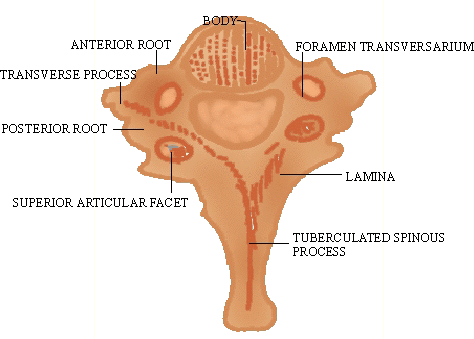|
PinkMonkey Online Study Guide-Biology
d) Vertebra Prominens or Seventh
cervical vertabra (Fig. 20.8).
(1) It is called the vertebra prominens because of its long and
thick prominent spinous process. (2) The spine is long, thick and
horizontal. (3) Spine is not bifurcated; ends behind in a tubercle
to which neck muscles are attached. (4) Big transverse processes
with big, prominent posterior root and long, slender anterior root. (5)
Foramen transversarium is small; may be double or absent.

Click Here To Enlarge
Figure 20.8
ii) Thoracic Vertebrae. Of the twelve thoracic vertebrae
(thoracic region) the second to the eighth thoracic are called typical
thoracic, while the first, and ninth, through the twelfth thoracic
vertebrae present special features, hence called atypical thoracic
vertebrae.
a) Typical thoracic vertebra (Fig. 20.9).
(1) It is identified by the presence of long spine
which passes backwards and caudaully and ends in tubercle for articulation
with ribs (except last two or three vertebrate). (2) Body
bears two costal facets on each side which articulate with heads
of ribs. (3) Transverse processes are large and, club-shaped,
face laterally and backwards and bear a facet on anterior side for
articulation with the tubercles of a ribs.
[next page]
|
Table of Contents
20.0
- Introduction
20.1 - Axial Skeleton
20.2 - Appendicular Skeleton
|